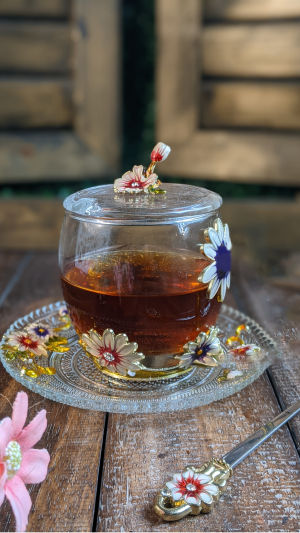Scented tea, a beverage crafted from flowers as its primary raw material, seamlessly combines the rich aroma of tea leaves with the distinct flavors of various flowers, offering a refreshing and fragrant experience.
Scented tea is not only celebrated for its delightful taste but is also believed to harbor numerous health benefits.
1. Types of Scented Tea
There exists a diverse array of scented teas, with some of the most common ones being:
1.1 Rose Tea
Rose tea, derived from roses as its main raw material, exudes a gentle floral scent and is reputed for its potential to regulate mood and enhance sleep quality.
1.2 Honeysuckle Tea
Honeysuckle tea, featuring honeysuckle as its primary ingredient, possesses the ability to clear heat and detoxify. It is commonly consumed during colds or fevers.
1.3 Chrysanthemum Tea
Chrysanthemum tea, crafted from chrysanthemums, offers a blend of benefits including heat clearance, improved eyesight, detoxification, and reduced swelling. Its light chrysanthemum fragrance is truly memorable.
1.4 Jasmine Tea
Jasmine tea, made with jasmine flowers, undergoes a unique production process resulting in a fragrant and fresh taste that is widely adored.
1.5 Osmanthus Tea
Osmanthus tea, utilizing osmanthus flowers, carries a distinctive osmanthus aroma. It is often employed to regulate appetite and alleviate indigestion.
2. How to Prepare Scented Tea
The preparation of scented tea typically involves the following steps:
2.1 Material Preparation
Based on the chosen scented tea variety, gather the corresponding flowers and tea leaves. Ensure the use of fresh and clean ingredients.
2.2 Proportional Allocation
Adjust the proportion of flowers and tea leaves according to personal taste and the type of scented tea. Generally, flower proportions can be fine-tuned based on individual preferences.
2.3 Brewing
Place the prepared flowers and tea leaves into the tea set, pour an appropriate amount of hot water, and carefully control the water temperature and steeping time. Different scented teas have distinct optimal brewing conditions.
2.4 Filtering
After steeping, employ a tea strainer or filter to strain out the tea soup, ensuring a clear and residue-free beverage.
2.5 Seasoning
Enhance the taste of scented tea by adding honey, lemon, or other condiments according to personal preference.
3. Historical Origins of Scented Tea
The history of scented tea dates back to ancient times, with diverse regional characteristics throughout history. In China, with its rich tea culture, scented tea has been an integral part of this tradition since the Tang Dynasty.
In Japan, scented tea finds its place in the tea ceremony culture, which emphasizes the artistry of tea and tea sets. Scented tea is frequently incorporated into tea ceremony performances and gatherings.
4. Scented Tea and Cultural Traditions
Scented tea transcends its role as a mere beverage; it is a cultural manifestation. In China, scented tea is often associated with significant occasions such as traditional festivals and weddings. People express their love for life and pursuit of beauty by savoring tea and appreciating the fragrance of flowers.
With its unique flavor profile and cultural significance, scented tea has earned its place among the diverse array of teas and is warmly embraced by enthusiasts.
Through an exploration of scented tea types, production methods, historical roots, and cultural traditions, we aim to provide readers with a comprehensive and nuanced understanding of this traditional drink.
As you savor the delicious taste of scented tea, may you also appreciate the profound cultural heritage embedded within this time-honored beverage.





